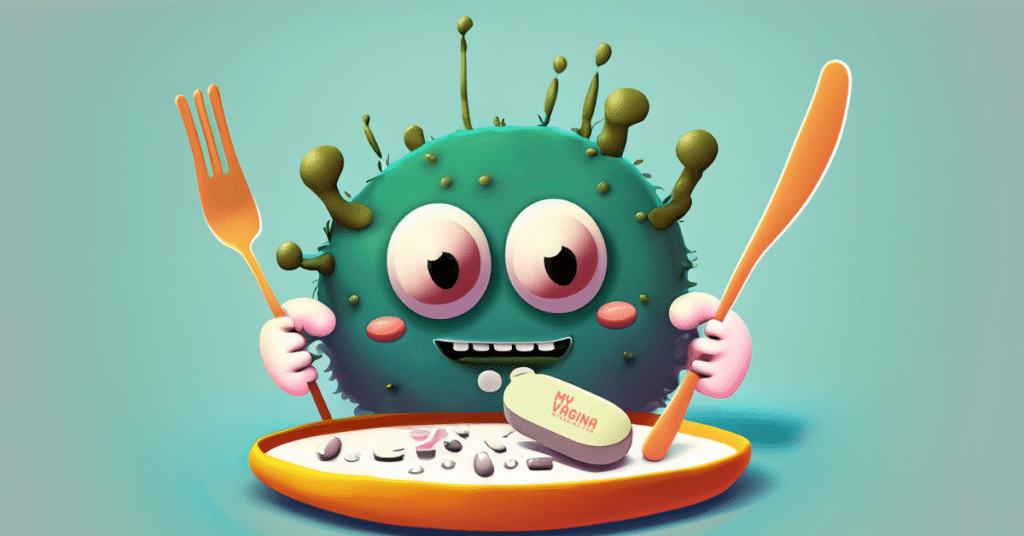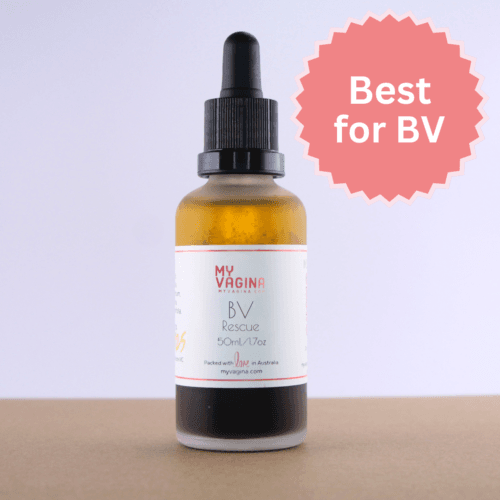You may have a diagnosis of bacterial vaginosis (BV) with or without symptoms. Either way the problem is the same: disruptive bacteria have colonised the vagina. Often, these bacteria make a sticky bacterial biofilm1–3 on your vaginal cells to protect their colony from treatments.
The usual treatment for BV is antibiotics, however, the three-month success rate of antibiotics is about 50 per cent.4,5
What is a BV biofilm?
In many cases, BV may become chronic. The bacterial biofilm produced by disruptive vaginal bacteria doesn’t resolve, stuck to the fabric of your vagina, the epithelial cells.
This biofilm and bacteria cause the vagina to become less acidic, kills off the protective Lactobacillus, and causes unpleasant symptoms. Antibiotics merely put a few bullet holes in the biofilm, but they are not effective in dissolving it.
Antibiotics work for some people and are an option, but if the drugs aren’t working, there are other effective natural options. Enrol in Killing BV and learn about BV, and how to treat it effectively.
Antibiotics most commonly used to treat BV
- Metronidazole (Flagyl, oral, MetroGel, vaginal) – most commonly prescribed
- Clindamycin (Cleocin, oral or vaginal, Clindesse, vaginal)
- Tinidazole (Tindamax, oral)
How to treat BV biofilms
If you have tried antibiotics, and they haven’t worked, you may be treating the wrong bacteria, have antibiotic-resistant bacteria, and strong biofilms.
Many microbes aren’t detectable by regular cultures so may remain undetected. Get a comprehensive vaginal microbiome test to get the full story, and join us in Killing BV for effective treatments.
We use ingredients that draw minerals out of the biofilm matrix, collapsing its structure, leaving the bacteria underneath susceptible to our effective herbal medicine.
The most comprehensive vaginal microbiome test you can take at home, brought to you by world-leading vaginal microbiome scientists at Juno Bio.
References6,7
- 1.Machado D, Castro J, Palmeira-de-Oliveira A, Martinez-de-Oliveira J, Cerca N. Bacterial Vaginosis Biofilms: Challenges to Current Therapies and Emerging Solutions. Front Microbiol. Published online January 20, 2016. doi:10.3389/fmicb.2015.01528
- 2.Sousa LGV, Pereira SA, Cerca N. Fighting polymicrobial biofilms in bacterial vaginosis. Microbial Biotechnology. Published online April 12, 2023:1423-1437. doi:10.1111/1751-7915.14261
- 3.Verstraelen H, Swidsinski A. The biofilm in bacterial vaginosis: implications for epidemiology, diagnosis and treatment: 2018 update. Current Opinion in Infectious Diseases. Published online February 2019:38-42. doi:10.1097/qco.0000000000000516
- 4.Abbe C, Mitchell CM. Bacterial vaginosis: a review of approaches to treatment and prevention. Front Reprod Health. Published online May 31, 2023. doi:10.3389/frph.2023.1100029
- 5.Muñoz-Barreno A, Cabezas-Mera F, Tejera E, Machado A. Comparative Effectiveness of Treatments for Bacterial Vaginosis: A Network Meta-Analysis. Antibiotics. Published online August 13, 2021:978. doi:10.3390/antibiotics10080978
- 6.Khedkar R, Pajai S. Bacterial Vaginosis: A Comprehensive Narrative on the Etiology, Clinical Features, and Management Approach. Cureus. Published online November 10, 2022. doi:10.7759/cureus.31314
- 7.Muzny CA, Sobel JD. The Role of Antimicrobial Resistance in Refractory and Recurrent Bacterial Vaginosis and Current Recommendations for Treatment. Antibiotics. Published online April 9, 2022:500. doi:10.3390/antibiotics11040500
Get a fresh perspective with a qualified, experienced vulvovaginal specialist naturopath.
This product has multiple variants. The options may be chosen on the product pageThe most comprehensive vaginal microbiome test you can take at home, brought to you by world-leading vaginal microbiome scientists at Juno Bio.
Easy-to-use BV and AV treatment program.
Promote and support a protective vaginal microbiome with tailored probiotic species.







